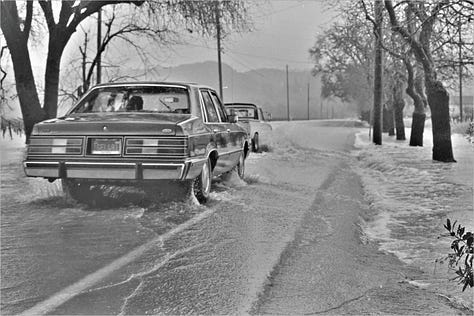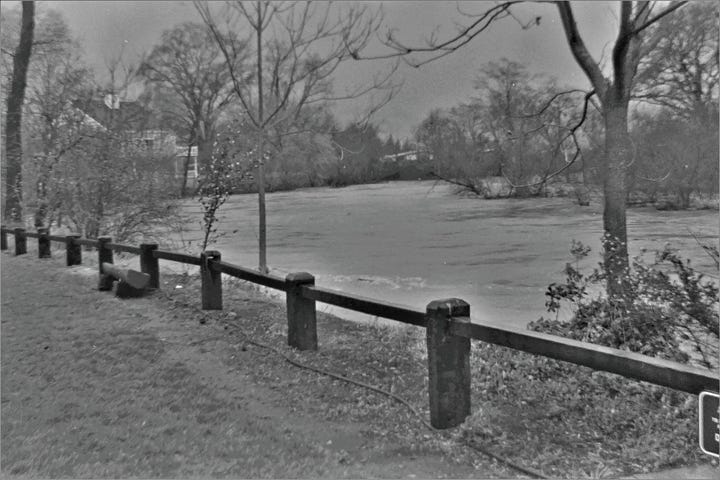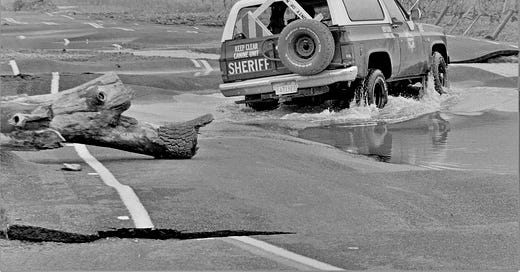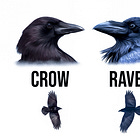Green Wednesday: Napa's Historic Floods and Flowering Quince
By Cindy Watter, UC Master Gardener of Napa County and Mariam Hansen, St. Helena Historical Society
We Need Your Help
If you’re reading this, you care about independent, locally owned, ad-free journalism — reporting that puts our region’s stories first, not corporate interests or clickbait.
Join a community that values in-depth, independent reporting. Become a paid subscriber today — and if you already are, thank you. Help us grow by liking, commenting and sharing our work.

Green Wednesday: Gardening and Ecological Insights
Every Wednesday Napa Valley Features brings you Green Wednesday, featuring articles from environmental voices and the UC Master Gardeners of Napa County. These contributors share research-based horticultural advice and insights on sustainability and climate topics relevant to our region.
Summary of Today’s Stories
"Historic Napa Valley Floods" by Mariam Hansen, our local historian, is an in-depth look at the catastrophic Great Flood of 1862 and its long-lasting impact on California’s landscape, economy and Napa Valley's flood management strategies.
The Central Valley became an inland sea that stretched 300 miles from north to south and ranged from 12 to 60 miles wide — Mariam Hansen
"Greet the Season With Flowering Quince" by Cindy Watter, UC Master Gardener of Napa County, celebrates the beauty and resilience of flowering quince, a low-maintenance early bloomer that attracts pollinators and offers edible fruit for jams or chutneys.
[Quince plants become] a bouquet bursting with flowers, welcoming spring — Cindy Watter
Historic Napa Valley Floods
By Mariam Hansen, St. Helena Historical Society
NAPA VALLEY, Calif. – Atmospheric rivers strike the U.S. West Coast several times a year on average, but can strike even more often in a particularly stormy year. Megastorm atmospheric rivers, like what struck in 1861-1862, occur about every 150 to 200 years and probably pose a greater risk to the state than earthquakes.
On Feb. 4, 2025 water surged from the spillway at Conn Dam in St. Helena. Built in 1948, the spillway was designed as part of the dam’s flood control system. — Tim Carl Video
California became a state on Sept. 9, 1850 in the middle of a crippling 20-year drought. By 1861, farmers and ranchers were praying for rain. In late November 1861, early winter storms dumped heavy snow in Northern California and Oregon. In early December, temperatures rose and the snow started melting, saturating the parched soils of the Central Valley.
On Dec. 9, a huge storm rolled in from the Pacific, followed by waves of torrential storms along the West Coast from Mexico to Canada that lasted for weeks, filling streams, rivers and normally dry washes and lakebeds.
By early January 1862, California was soaked, but on Jan. 9, two superstorms hit back to back. On Jan. 18, a heavy downpour lasted more than 24 hours, but finally brought an end to the 43-day deluge that had produced more than 10 feet of rain and snow.



As spring temperatures rose, the heavy snowpack melted, causing continued inundation of towns and fields in California and surrounding states for months. The Great Flood of 1862 remains the largest flood in the recorded history of California, Nevada and Oregon. Streams and rivers emanating from the Sierra Nevada became treacherous torrents, sweeping entire towns and mining camps away.
The Central Valley became an inland sea that stretched 300 miles from north to south and ranged from 12 to 60 miles wide. The San Gabriel and San Diego rivers cut new channels to the sea, but severe flooding in Southern California was less devastating than farther north because it was very sparsely populated at the time, with only 11,333 people living in Los Angeles County.
In 1860, the population of California was 379,994, and most lived in the Central Valley. California’s state capital, Sacramento, was located in a broad floodplain at the intersection of the Sacramento and American rivers. John Sutter declined to build his city there, but his son began to sell lots anyway.
On Feb. 4, 2025, the Napa River roared beneath the Pratt Avenue Bridge as seen from Silverado Trail in St. Helena. — Tim Carl Video
On Jan. 10, 1862, the levees around Sacramento broke, flooding the city and forcing the newly elected governor, Leland Stanford, to travel by rowboat to the flooded capitol building for his soggy inauguration. On Jan. 22, the entire state legislature relocated to San Francisco for six months while Sacramento dried out. At least 21 people died.
Flooding destroyed one in eight houses and carried mining equipment great distances. As much as 25% of California’s taxable property was destroyed and the state was nearly forced to declare bankruptcy due to the costs of damages and the lost tax revenue.
It is estimated that 100,000 sheep and 500,000 lambs were killed, and 200,000 of California’s 800,000 head of cattle drowned or starved. This forced California to change from a ranching economy to the prolific agricultural region we know today: “America’s Salad Bowl.”
Historic data from Napa River levels show that the most likely months for high water or flooding are January and February. There have been about 22 floods on the Napa River since 1865. Stream flow data is available back to 1930.




Looking back to 1881, it rained 13 inches in 54 hours. The rain started on Jan. 27, a Thursday night, and stopped Sunday morning, Jan. 30. The Napa River rose 21 feet and spread out over the valley. It was 2 feet higher than 1862. The railroad tracks flooded between St. Helena and Calistoga. No rail service meant no passengers or goods could move. The Pope Street Bridge across the Napa River was made of wood at that time since the stone bridge was not built until 1894. Men were tasked with keeping the drifting fencing, posts, grape stakes and rubbish from wrecking the bridge. The new Lodi Lane Bridge was swept away, as was the Rutherford Crossroad Bridge.
Since 1862, 28 major floods have struck the Napa Valley, including in 1938, 1955, 1963, 1967, 1973, 1978, 1981, 1983, 1986, 1993, 1995, 2002 and 2006. In 1986, the Napa River peaked on Feb. 17, causing $20 million damage to the area. In 1995 the river flooded in January and March.
Flood stage for the Napa River at Pope Street is 18 feet. On New Year’s Eve 2005, the Pope Street Bridge water level was 23.61 feet and flood damage was estimated at $3.8 million. Residents of Vineyard Valley Mobile Home Park, Hunts Grove Apartments, Meadowcreek and Ogletree Apartments were evacuated.
St. Helena Flood Project planning began in earnest in 2004 with the awarding of a $5 million flood control grant from FEMA. Much debate ensued about designing a project according to “living river principles” without concrete or riprap. Archeologists discovered significant Native American artifacts during their required study, causing further delays. Residents of Fulton Lane sued to stop the project in 2009 and the land needed from Vineyard Valley owners was fought over.
Millions of dollars in funding from many public sources had to be found. Finally, the project was completed in 2010. In 2013, the engineers for the project, Mead & Hunt, were recognized for their project design.
On Feb. 7, 2017, the Napa River at Pope Street reached the 19-foot flood stage briefly. Several roads were closed. The flood control project seems to have worked. On Feb. 27, 2019, the Napa River reached peak flows again, but there were no damage reports between Pope Street and Fulton Lane.
Later it was found the city of St. Helena did not account for FEMA funds properly, causing major problems, but that is a topic for another day.
—
Mariam Hansen is research director for the St. Helena Historical Society.
Greet the Season With Flowering Quince
By Cindy Watter, UC Master Gardener of Napa County
NAPA VALLEY, Calif. — A few years ago, I planted three flowering quinces in my backyard. I chose them because they are early flowering plants — late winter or early spring — and they are so pretty. I have dark-rose, pink and white flowering quinces, and right now they are abuzz with bees and hummingbirds. The flowers don’t last long, but they add a happy splash of color this time of year.
Flowering quince (Chaenomeles japonica) was called “japonica” when I was growing up. “Japonica” refers to its homeland. It was brought to America from Japan in the 1800s and quickly became popular. It is easy to care for and attractive, and it grows into a useful hedge. (The stems have 2-inch spikes.)
Do not confuse flowering quince with the quince tree, which produces fruit the size of a large pear. Many flowering quinces today have been bred to be sterile and don’t produce fruit. Mine, however, regularly give me enough quinces to make a small batch of chutney or jam. The fruits aren’t as big as the fruit on a quince tree, but they have the same floral flavor. They make excellent jams and jellies because of their high pectin content.
Note: Do not try to eat a raw quince. They are stone-hard and bitter. However, they are delicious when cooked. Read more about cooking with quince in “Rediscovering Quince, California's Forgotten Fall Fruit,” By Georgeanne Brennan.
Flowering quince is a member of the rose family. Just as rose hips are a good source of vitamin C, so are quinces. The plant prefers full sun and a slightly acidic loamy soil. Once established, it doesn’t need much water, maybe an inch a week. Fertilize in early spring and loosen the soil with compost a couple of times a year.
The Japanese quince grows to about 3 feet tall; other varieties of flowering quince grow to 6 feet. If you want to prune it, do so after it flowers to encourage even more flowers next spring. Flowering quince is not invasive, so it won’t infringe on any native plants in your yard.
It is easy to propagate a flowering quince. At the end of the summer, cut a few stems from the previous year’s growth. The stems should be about the same diameter as a pencil. Remove all leaves except for the top leaves. Using a very sharp tool, peel the end of the cutting to expose the cambium layer immediately under the bark. This layer is where growth occurs.
Place the cutting in a porous potting mixture, water it and cover the potted plant with a plastic bag. Keep it out of direct sun and keep the soil moist but not damp. The cutting should root within a month. Gently pull on it to check. Wait another month before planting it outdoors.
Growing a flowering quince from seed is a bit more complicated. First the seeds must be chilled for 60 to 90 days to imitate winter cold. (This step alone takes me out of the game as my family is confused when anything besides food ends up in the refrigerator.) Then you put the seeds in moistened soil in a pot and cover the pot with a plastic bag, as described above.
When the seeds germinate and the seedlings have produced two sets of leaves, transplant them to small pots. Continue to keep the soil moist but not damp. When the seedlings are 12 inches tall, you can plant them outside.
I just noticed a new flowering quince in a neglected corner of my yard. I did not plant it. I can only surmise that a disappointed squirrel dropped an inedible quince from another plant and it rotted away, exposing some seeds. Then nature took over.
Some people complain that the flowering quince bloom season is so short. Maybe we should learn to appreciate plants at all stages of their growth. The natural architecture of a flowering quince is striking, with its dark leaves and spiny stems.
There is a low, trimmed hedge of flowering quinces in different colors in my neighborhood. I admire it every day on my walk. It looks like it belongs in an English knot garden. However, in my yard, I prefer the naturally exuberant shape of a flowering quince. It is a bouquet bursting with flowers, welcoming spring.
Events
Tree Walk: Join UC Master Gardeners of Napa County for a free guided tree walk on Sunday, April 6, from 10 to 11:30 a.m. at Fuller Park in Napa. Discover some of the many exotic and native trees planted at Fuller Park over the past 120 years. Please meet in the park at the corner of Oak and Jefferson streets. Reservation required.
Tomato Growing Workshop: Join UC Master Gardeners of Napa County for “All About Tomatoes,” a Zoom workshop, on Sunday, April 13, from 2 to 3 p.m. Learn about types of tomato plants and how to care for them, including soil and watering needs, staking, pest prevention and more. The workshop is free, but you must register to receive the Zoom link.
Tomato Plant Sale: The annual Napa County Master Gardeners Tomato Plant Sale is Saturday, April 12, from 9 a.m. until sold out, at 1710 Soscol Ave. in Napa. Seedlings are grown locally by Master Gardeners and are $5 each. Stop by the education tables and consult with our tomato pros. The list of available varieties is here.
Help Desk: The Master Gardener Help Desk is available to answer your garden questions on Mondays and Fridays from 10 a.m. until 1 p.m. at the University of California Cooperative Extension Office, 1710 Soscol Ave., Suite 4, Napa. Or send your questions to mastergardeners@countyofnapa.org. Include your name, address, phone number and a brief description of the problem. For best results attach a photo.
—
Cindy Watter is a UC Master Gardener of Napa County.
—

















That ‘86 flood was something else. They had just paved the Yountville cross road. The flood waters just picked up a strip 20’ long by 4” thick new asphalt and moved it about 20’ south. That was also the year I got caught in the flood coming back from visiting an artist friend in residence at Montalvo. I was zipping up 29 just ahead of road closures. Got to Zinfandel only to find I couldn’t get into St Helena. So I took Zinfandel across the valley. Toward the end the road had water on it, but I watched a Miata drive through it. I figured if a Miata could make it, so could I in a slightly larger car. Deer Park and Silverado Trail was flooded so I took Conn Valley, but decided not to try Old Howell Mountain. I ended up leaving my car at Rick Foreman’s place and trudged over Mund Road only to find a huge downed tree blocking Deer Park. A friend and my landlord were sitting on the other side of the tree, waiting to rescue me. I clamored over the tree and eventually made it home to a warm, dry house. (Those were the days when PG&E actually maintained power through rough storms.) It only occurred to me several years later that I had actually driven through the Napa River. (This was also before the slogan “Turn around, don’t drown.” Was prevalent.)